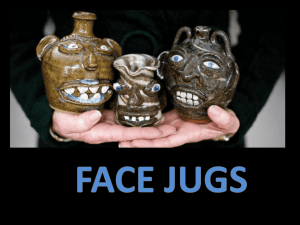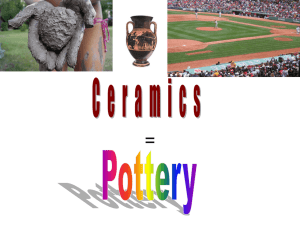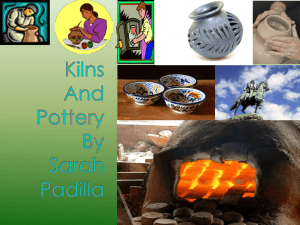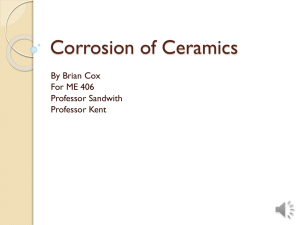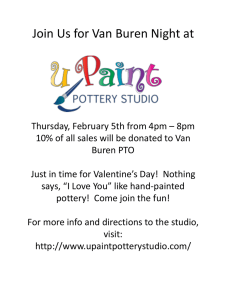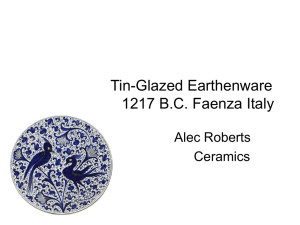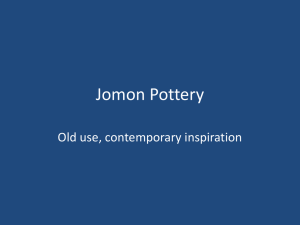Visit to a pottery workshop
advertisement
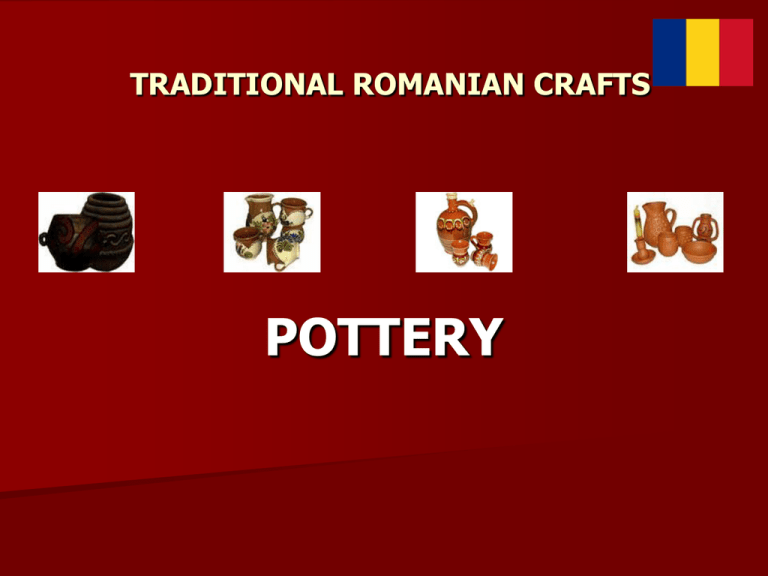
TRADITIONAL ROMANIAN CRAFTS POTTERY CONTENTS History of pottery in Romania Fokloric legends about potters Pottery Centres of ceramics in Romania Visit to a pottery workshop HISTORY OF POTTERY IN ROMANIA Pottery is one of the first crafts that has been practiced since the Neolithic period. The processing of the clay required special knowledge (modelling, decoration, burning) which had to be transmitted from generation to generation, having an important role in the development of the primitive society. În the geographic space between the Carpathians and the Danube, there were found archeological proofs regarding the early practice of pottery in the Neolithic period. HISTORY OF POTTERY IN ROMANIA Beginning with Vth-IVth B.C., the Geto-Dacians made different household articles through pottery, using pottery kilns and pottery wheels, also adopting superior techniques from Greece and from the Roman world. Thus it can be proved through pottery that the Geto-Dacians had, at that time, a civilizing role in the south-east of Europe. HISTORY OF POTTERY IN ROMANIA In the Roman Dacia, after 106, the products of the local craftsmen were in competition with the imported luxury ceramic products, but this only succeeded to improve the quality of the DacoRoman pottery regarding the common items. The pottery workshops were archeologically confirmed to have existed in almost all urban Dacic centres. Among the Roman colonists, there were also brought potters from other parts of the Empire. HISTORY OF POTTEY IN ROMANIA Even after the withdrawal of the Roman army and administration to the south of the Danube, pottery continued to be practiced in the north (the post-Roman Dacia). The conditions were difficult and so pottery was practiced in the areas that were protected against the violent migrators. The old technology of the DacoRoman pottery was used continuously until VIIth century. HISTORY OF POTTERY IN ROMANIA In ancient times, the potters were grouped and formed factions of 200-300 families. They could be found in all villages, in the vicinity of fairs and near more important royal residences. People usually looked for potters especially around traditional holidays, at fairs, weddings or baptisms. FOLK LEGENDS ABOUT POTTERS Potters have always been invested with demiurgic qualities, as they created new forms from paste. The Romanian legends say that potters acquired their skill from God, but as they did not have divine breath, they burned the products so that they should last forever. According to old beliefs, here has to be sought the origin of the metaphor which identifies the clay container with the human body, a figure of speech valued so much in the most important creations of the universal poetry. FOLK LEGENDS ABOUT POTTERS Also, the potter was considered a sinful man and there is the faith that on the other world he will have to work a lot because he burned and tortured the ground. POTTERY Men take the clay from special places, bring it at home and knead it with their hands, feet or with a big wooden hammer, mixing it with water. The paste produced in this way is cleaned of impurities, by cutting it into thin slices which are then modeled with the pottery wheel. POTTERY The wheel is formed of two discs, a smaller one on the top and a bigger one at the bottom. They are joined by a vertical axis. The potter puts the piece of clay on the upper disc and he moves the other disc with his feet, in a fast circular movement. POTTERY The form of the pot requires a special technique and high working speed because the paste should not get dry. After modeling, the pots are left to dry for a few days, in the shadow, then they are burned in special ovens after having been decorated first. POTTERY The most common technique of decoration means using a cow’s horn with a goose feather on top. The colour goes through the horn to the goose feather. Thus we have a real pen. The delicate decoration can be obtained by using a small stick and boar hairs. POTTERY Another type of decoration can be obtained with a metallic tip, after dipping it into colour. Another technique, common in the south of Romania, is the application of some cords, belts or roses of paste. CENTRES OF CERAMICS IN ROMANIA CERAMICS FROM HOREZU Horezu Ceramics centre appeared at the end of XVIIIth century and it is considered to be the most important ceramics centre from Romania. It was specialized in making bowls and trays and then it diversified its production by introducing cups, flower pots and jars. CENTRES OF CERAMICS IN ROMANIA CERAMICS FROM HOREZU Horezu pots have been made to be used mainly by noble families. The decorations that are used at Horezu are the vegetal (fir tree, clover, stalks), geometric (zig-zag, dots, lines) and others like: the rooster, the sun, the church, the spiral and the fish. CENTRES OR CERAMICS IN ROMANIA CERAMICS FROM HOREZU CENTRES OF CERAMICS IN ROMANIA CERAMICS FROM VAMA What is predominant for the Ceramics from Vama is the use of green, yellow and brown, the motifs being mainly geometrical (lines, circles, spirals) and floral. The main types of objects are those used in the house: pots for milk, sarmale, jugs, bowls, plates. At present there is only one potter who produces this type of ceramics, in the village Vama. CENTRES OF CERAMICS IN ROMANIA CERAMICS FROM VAMA CENTRES OF CERAMICS IN ROMANIA CERAMICS FROM OBOGA The ceramics from Oboga (south of Romania) is characterized by the colors brown, green and yellow. The most representative products are the plates with floral motifs (the tree of life, the acorn) or zoomorphic motifs (the peacock, the rooster, the fish) and also the famous wedding jugs, made exclusively in this region. CENTRES OF CERAMICS IN ROMANIA CERAMICS FROM OBOGA CENTRES OF CERAMICS IN ROMANIA CERAMICS FROM BAIA MARE The ceramic objects of this type are cobalt-blue, decorated with white motifs but also with brown, yellow, green. There is a wide variety of products, from plates (of different sizes) to bowls, water jugs, small cups, jugs, candlesticks etc. CENTRES OF CERAMICS IN ROMANIA CERAMICS FROM BAIA MARE VISIT TO A POTTERY WORKSHOP In the framework of the project we organized a documentary visit to a pottery workshop from our region. VISIT TO A POTTERY WORKSHOP The potter makes a demonstration VISIT TO A POTTERY WORKSHOP The potter presents the technique VISIT TO A POTTERY WORKSHOP Students working VISIT TO A POTTERY WORKSHOP Students working VISIT TO A POTTERY WORKSHOP Students’ final products TRADITIONAL ROMANIAN CRAFTS THANK YOU FOR YOUR ATTENTION!
